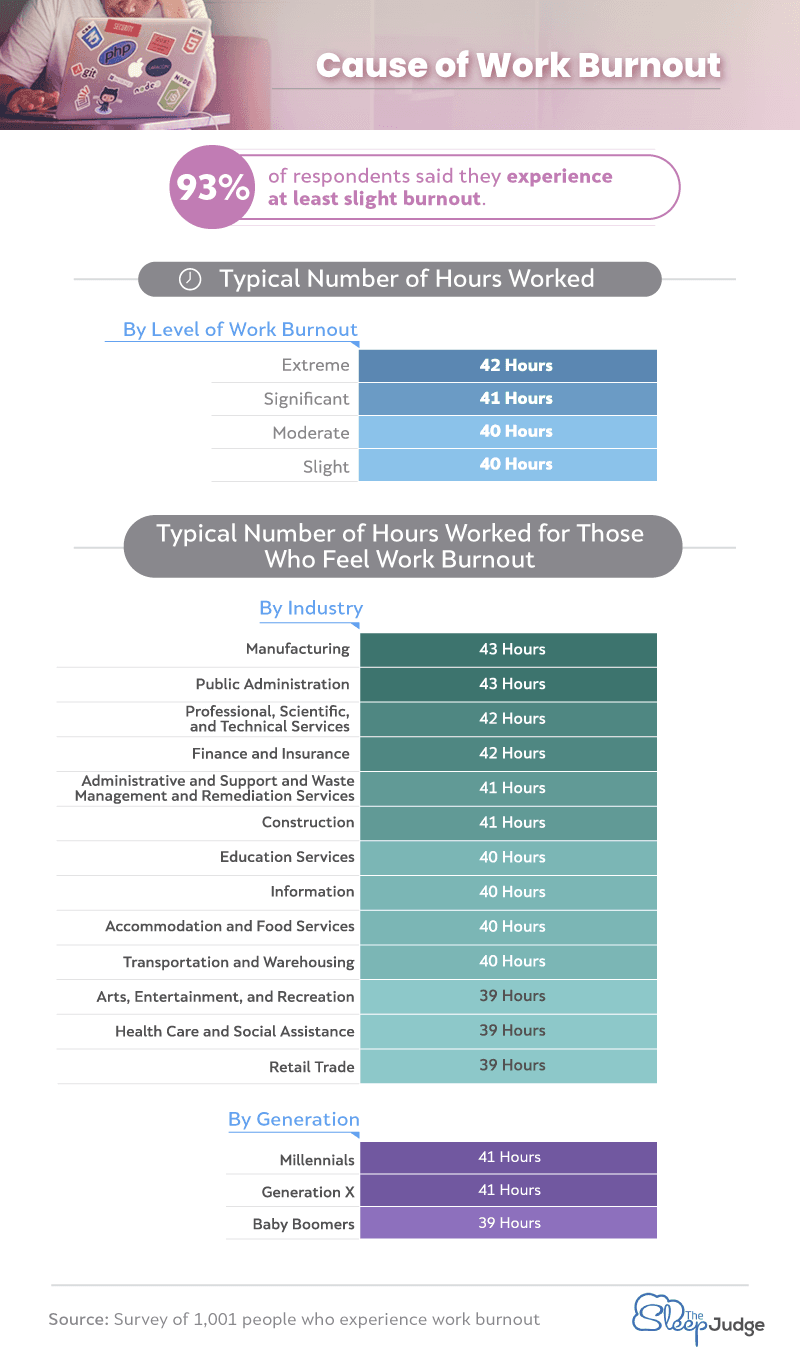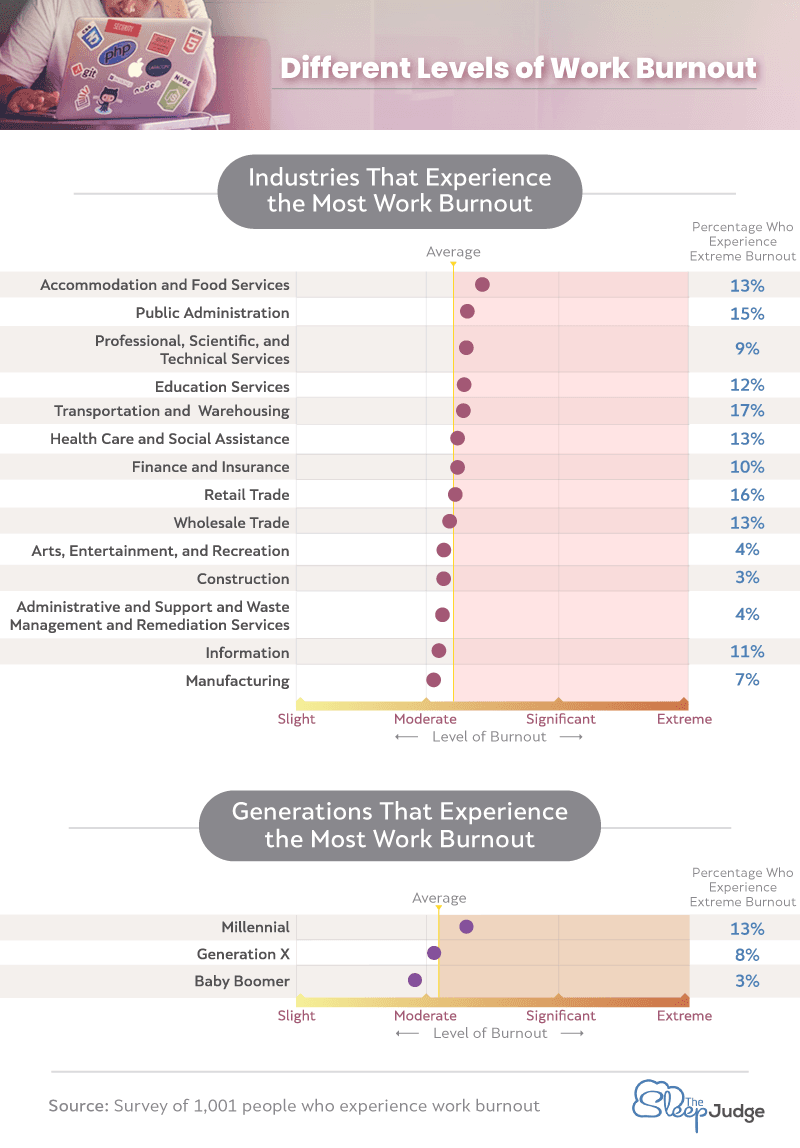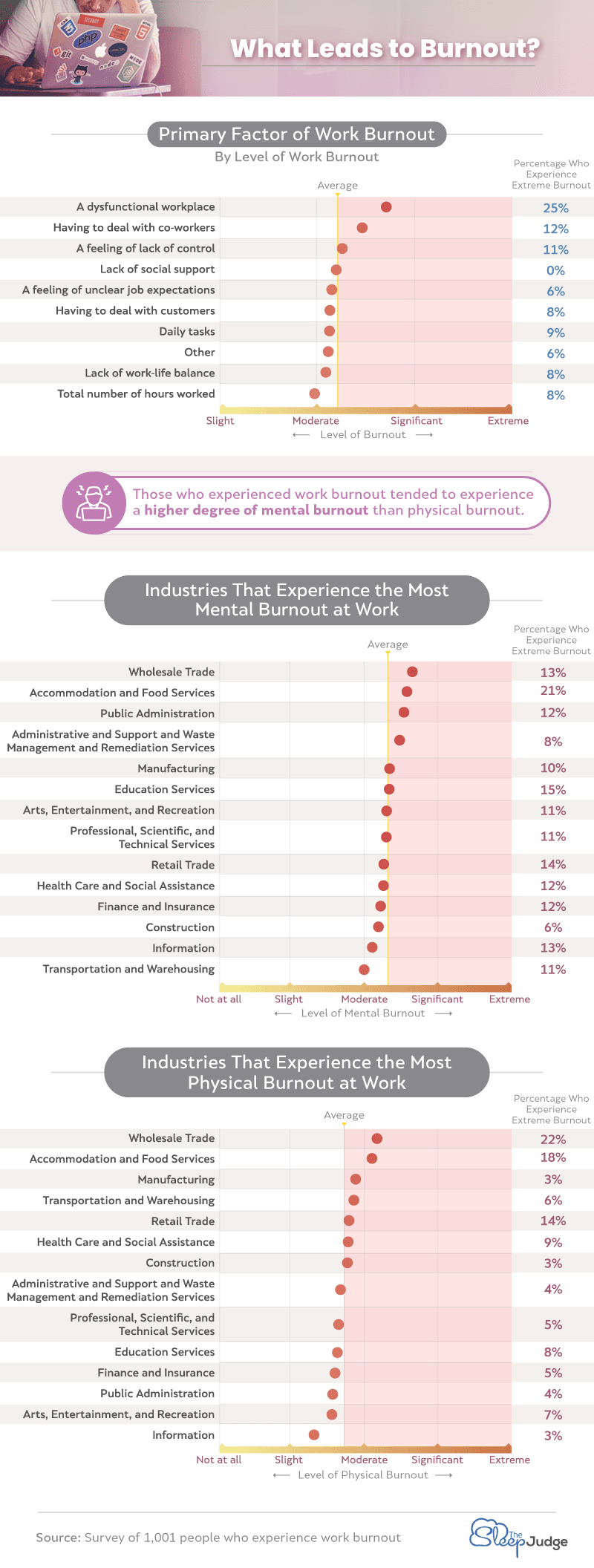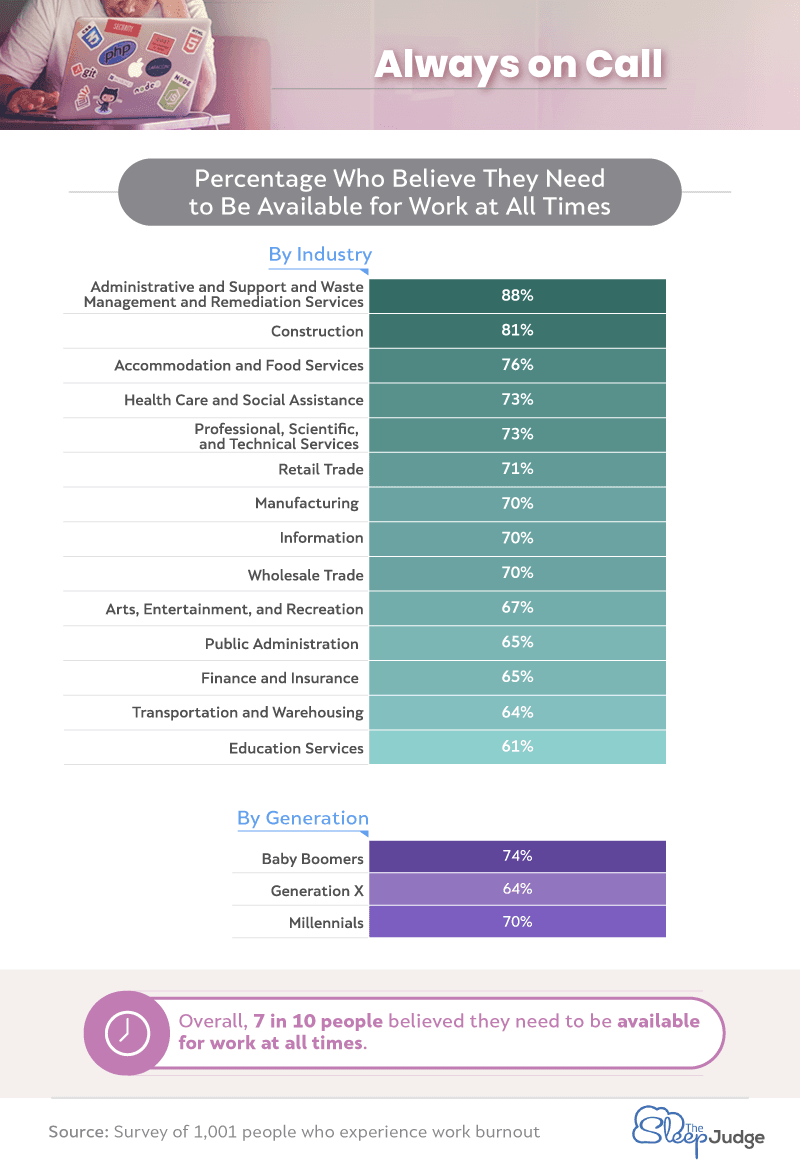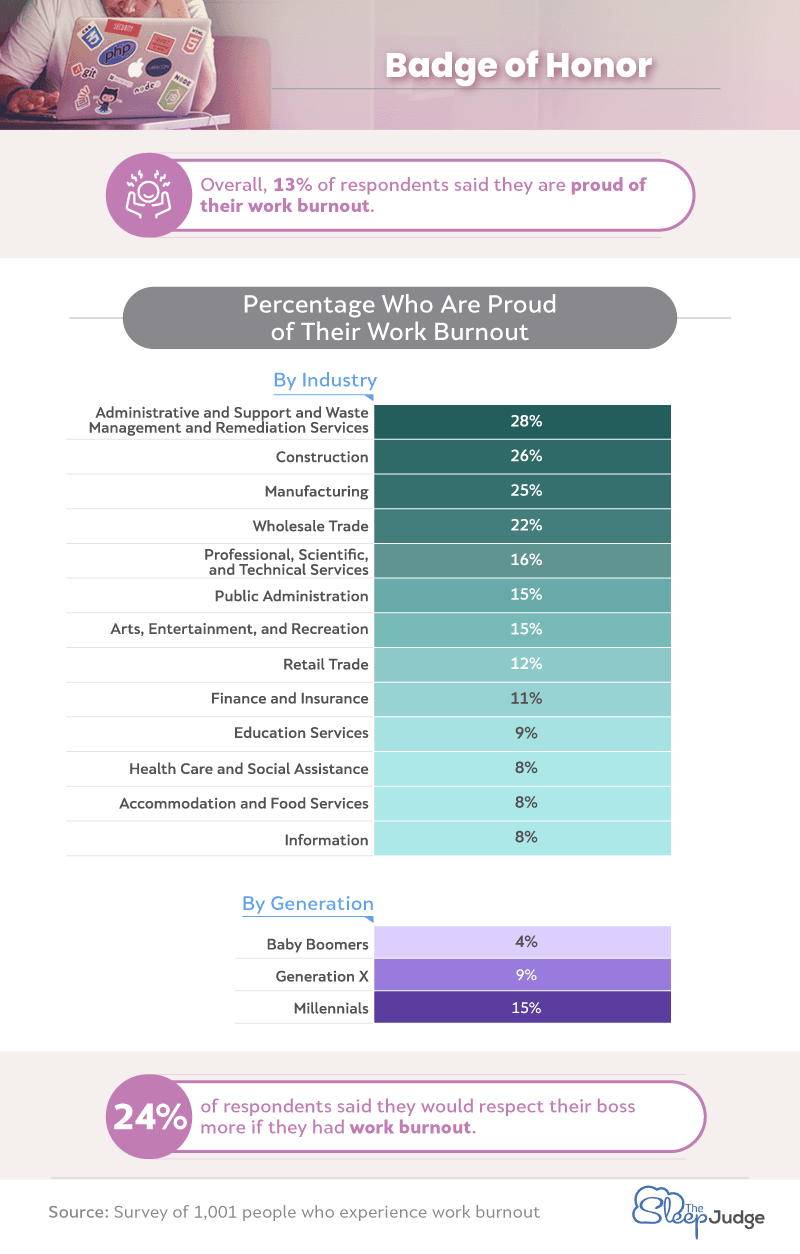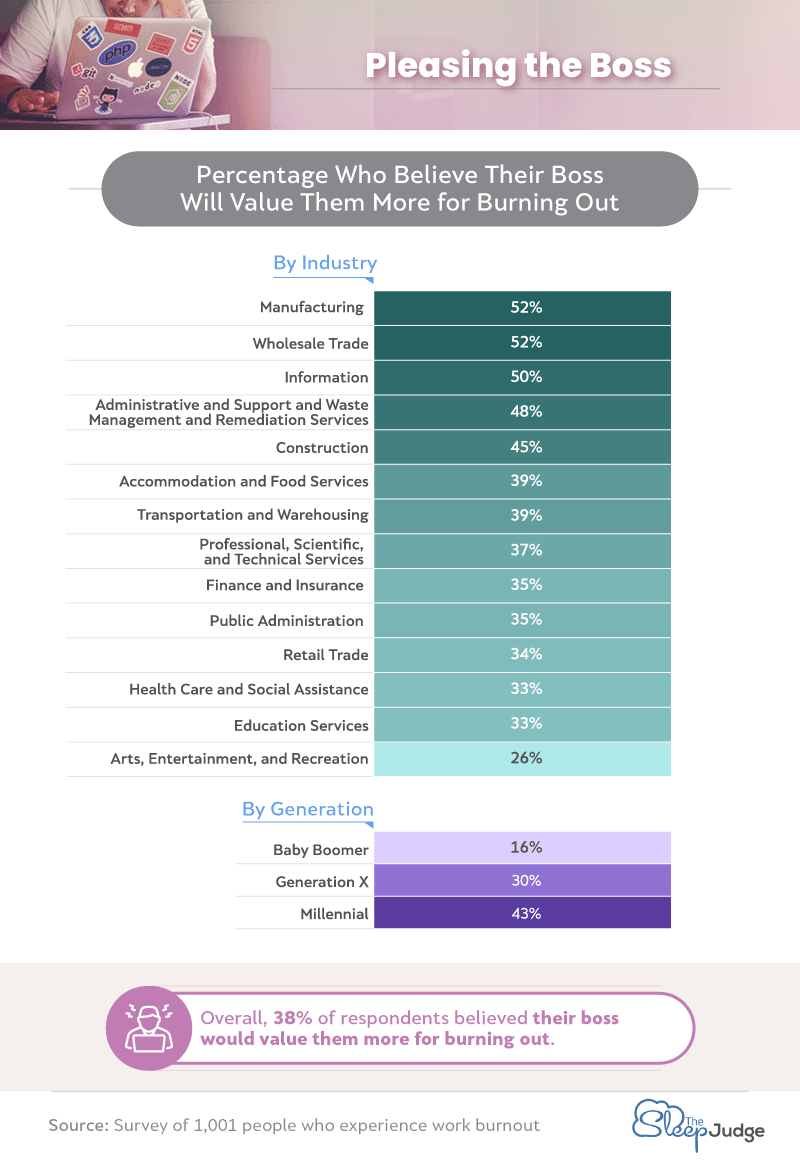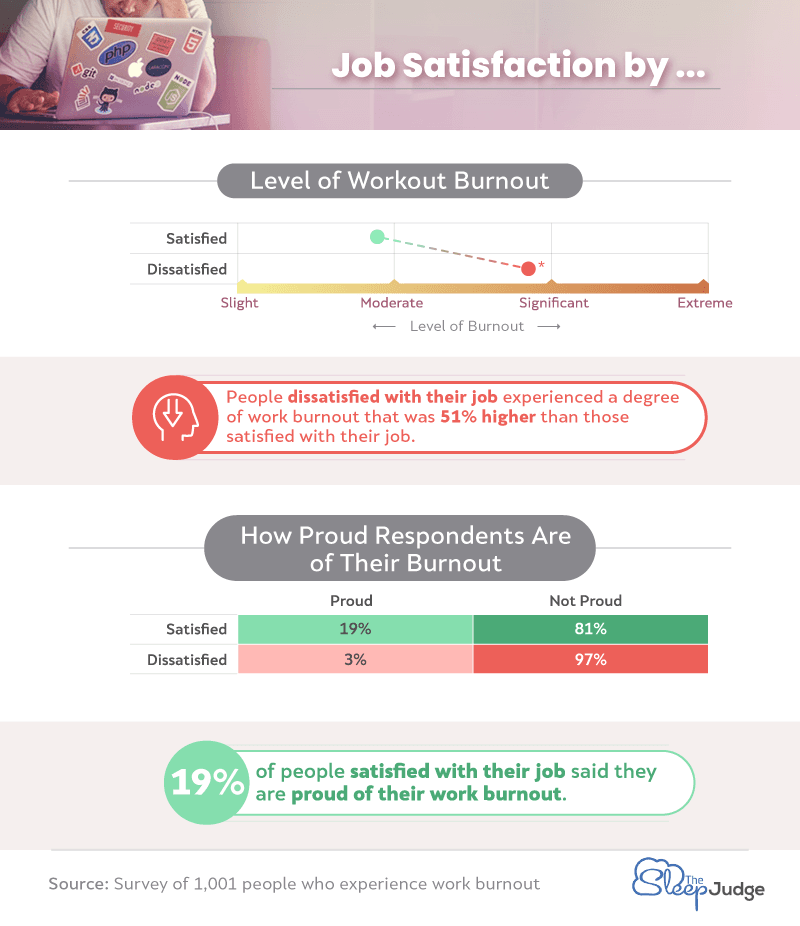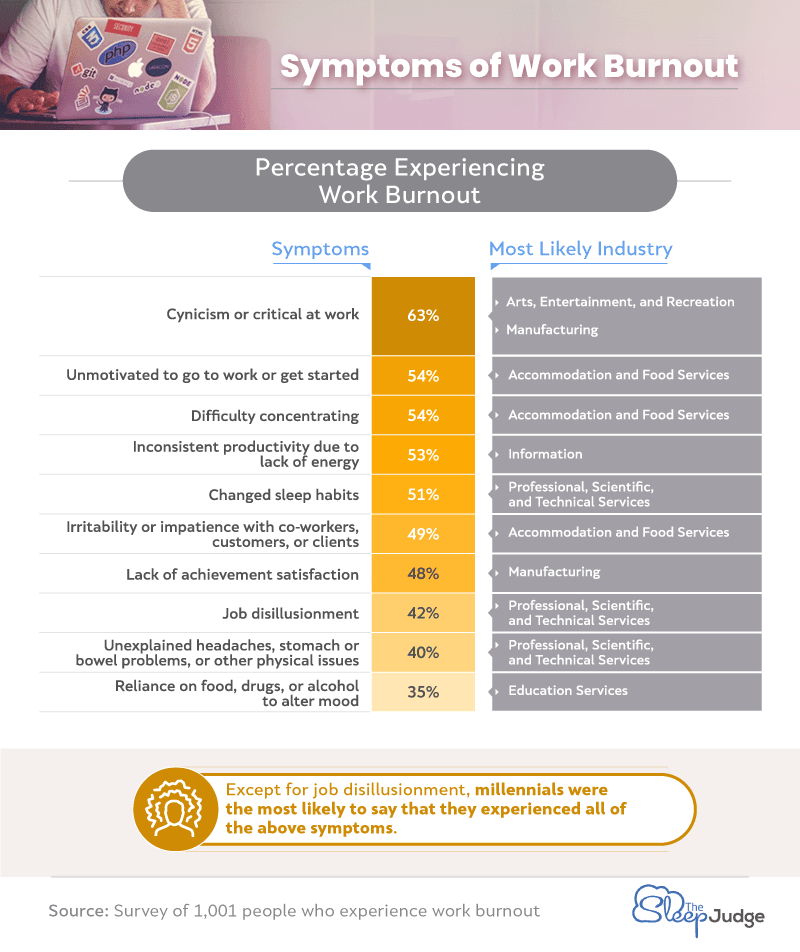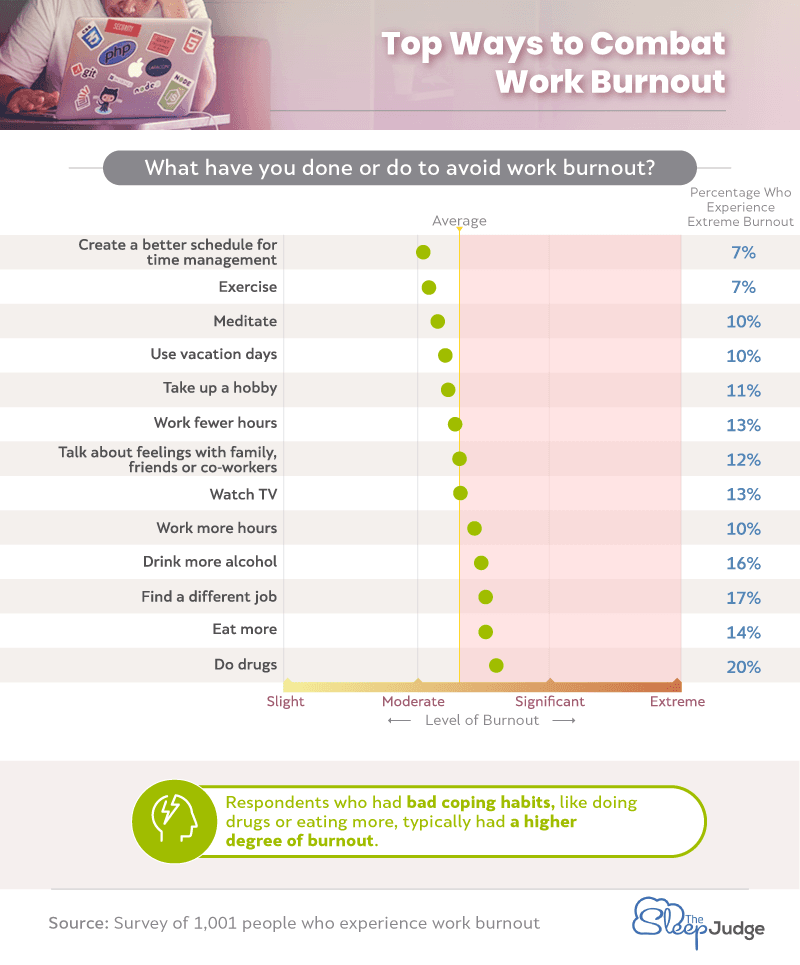The United States is the most overworked country in the developed world. Late nights working overtime, early morning meetings, and personal life and sleep sacrifices are a reality for most working Americans. But with a full-time job barely enough to financially get by, the stress that employees undergo can be taxing both physically and mentally. From headaches and sleep problems to anxiety and depression, too much stress can wear down your body and mental health. Leaving stress unchecked for too long can even cause high blood pressure, heart disease, obesity, and diabetes.
Despite these consequences, America still runs on overtime. How many employees are sitting behind their desks, completely checked out from exhaustion? Are the stresses at work following them home and preventing them from sleeping? To find out, we surveyed around 1,000 employees, getting all the details about their work burnout. Keep reading to see how many people actually experience burnout and what they do to relieve it.
Long Hours at the Workplace
Work burnout doesn’t just describe being tired of working. Rather, it’s a term defined by the Mayo Clinic as “a state of physical or emotional exhaustion that also involves a sense of reduced accomplishment and loss of personal identity.” Burnout also has numerous symptoms from being cynical at work to unexplained headaches, stomach problems, and other physical ailments. In fact, 93% of respondents experienced slight burnout at work.
While the full-time workweek typically consists of 40 hours, a significant portion of employees works more than eight hours a day, on average. Part-time workers were the only employees to clock in less than eight hours daily in 2017. As we learned, for those working more than 40 hours, the likelihood of work burnout increases. Respondents working 40 hours each week experienced burnout to a slight or moderate degree, while people working 41 hours a week felt significant burnout. Respondents who reported being extremely burned out worked an average of 42 hours per week.
Taking Burnout to a New Level
It’s normal for job hours to vary by industry, so who is working the most? Employees in the manufacturing and public administration industries clocked in an average of 43 hours per week despite experiencing work burnout, while those in the arts, health care, and retail trade worked the least with an average of 39 hours each week. While those in the accommodation and food services industry worked a typical 40-hour week, they were the most likely to say they experienced work burnout. However, when it came to the severity of burnout, employees in transportation and warehousing were the most likely to say they experienced extreme work burnout.
There are many reasons not to like a standard 9-to-5 job, and for millennials, it has nothing to do with being lazy. The younger generation simply doesn’t want to spend time at a job unrelated to their degree that doesn’t pay enough for financial security. Still, millennials experiencing burnout worked an average of 41 hours per week, more than baby boomers. While Gen Xers also worked an average of 41 hours, millennials report experiencing more extreme burnout compared to the other two generations.
Where Burnout Stems From
More weekly working hours may have been associated with a higher degree of burnout, but it wasn’t the biggest factor. Those experiencing the highest degree of burnout pointed to a dysfunctional workplace as the cause. Having to deal with co-workers and feeling a lack of control were also significant factors resulting in work burnout.
The U.S. has come a long way in shedding the stigma attached to mental health, but society still values physical health over mental health. However, respondents experienced mental burnout at a higher degree than physical burnout. Employees in accommodation and food services, education services, and retail trade reported experiencing extreme mental burnout more than any other industry. While employees across all industries reported physical burnout, the degree to which they experienced it was less, on average, compared to mental burnout. Some industries still reported extreme physical burnout, though, with the wholesale trade industry being the most likely to report their burnout as extreme.
Staying Connected to the Workplace
A major part of burnout is likely the stress that follows employees home. Even when they’re off the clock, emails, phone calls, and texts can still make their way through. The accessibility of technology leaves many employees feeling like they need to be available for work at all times. In fact, 88% of those working in the administrative and support and waste management and remediation services reported feeling the need to be on call at all times, while 81% of employees in construction said the same. Across all industries and generations, 70% of employees reported feeling the pressure. Luckily, for employees living in New York, some of the pressure may be relieved by a new bill prohibiting work emails and calls after hours.
Effort Equals Success?
The consequences of work burnout would lead most to think it’s a bad thing. But some people are actually proud of their burnout. Millennials were the most likely generation to wear their burnout as a badge of honor, while only 4% of baby boomers agreed.
However, when looking at industry, burnout pride increased. Almost 30% of those working in administrative and support and waste management and remediation services were proud of their work burnout, followed by 26% in construction and 25% in manufacturing. This pride likely stems from the belief that success is measured by the effort put in. Working hard is certainly an accomplishment and something to be proud of, but when hard work puts your health at risk, the cost may outweigh the benefits.
Higher Burnout for the Higher-ups.
Self-accomplishment may be enough to push some employees to work through burnout, but others may be pushed by the effect burnout has on their boss. Forty-three percent of millennials believed their boss would value them more for burning out, while 30% of Gen Xers and 16% of baby boomers agreed. In terms of industry, 52% of those working in manufacturing and wholesale trade thought their value was tied to overworking – at least in their boss’ eyes.
Got No Satisfaction
Aside from pride and impressing the boss, burnout has a significant impact on job satisfaction. Employees reporting a lesser degree of burnout were more likely to be satisfied with their job, while dissatisfaction grew with the degree of burnout. In fact, people who were dissatisfied with their job experienced a degree of burnout that was 51% higher than those who reported job satisfaction.
While the majority of people weren’t proud of their work burnout, regardless of job satisfaction, those who were proud were also more likely to be satisfied with their job. Compared to just 3% of employees who were proud of their burnout but dissatisfied with their job, 19% reported both pride and satisfaction.
Warning Signs of Burnout
Symptoms of work burnout differ for everybody, but the typical signs may either be difficult to spot or easy to confuse as something else. The most common symptom shared by 63% of respondents was being cynical or critical at work. Fifty-four percent also reported feeling like they dragged themselves to work and had trouble getting started once there. Difficulty concentrating, lack of energy, a change in sleep habits, and lack of satisfaction were also strongly associated with work burnout, but can also be mistaken for depression. Employees experiencing burnout may be at a higher risk for depression, but the best way to differentiate burnout from a bigger mental health problem is if the symptoms extend beyond work.
Preventing Burnout
Whether employees actively try to reach burnout, feel the pressure from their boss, or reach it unintentionally, how do people combat the symptoms? Employees experiencing lesser degrees of burnout chose to create a better schedule, exercise, or meditate. Some even chose to use vacation days to escape the cycle of overworking. However, those on the more extreme end of the burnout scale were more likely to use bad habits as a way of coping. Bad habits ranged from working more hours to drinking more alcohol and eating more. Employees who reported the most extreme burnout even resorted to doing drugs.
Too Much Stress, Not Enough Sleep
A long workweek is bound to leave energy levels low and employees looking forward to the weekend. But as the fatigue weighs heavier and heavier on both our mind and body, two days of relaxation may not cut it. Work burnout affects many Americans, and while some employees have it worse than others, some workers actively push themselves beyond the breaking point.
Burnout can impact mental and physical health in ways many might not realize. And leaving it unchecked can cause problems to be more severe. Creating a better schedule to practice time management, exercising regularly, and talking about your feelings with family and friends can be some of the best ways to avoid or manage job burnout. Hard work pays off, but working too hard can cost you.
Methodology
We gathered responses from 1,001 respondents on Amazon’s Mechanical Turk platform. To qualify for the survey, they had first to say they were either a part-time or full-time employee. Then they had to say they experienced work burnout at least slightly. Work burnout was defined to survey takers as “exhaustion of physical or emotional strength or motivation as a result of prolonged stress or frustration at one’s job.”
Fifty-one percent of respondents were men, and 49% were women. Sixty-two percent of respondents identified as millennials, 28% were from Generation X, 8% were baby boomers, 2% were fromGeneration Z, and <1% were from the silent generation.
If respondents failed an attention-check question halfway through the survey, they were disqualified and excluded.
People who said they typically work less than 21 hours a week or 56 hours a week were eliminated for being outliers.
Common symptoms of work burnout are as defined by the Mayo Clinic.
For industries to qualify for our survey, they had to have a minimum of 20 respondents.
Fair Use Statement
Not proud of working yourself into the ground and want to prevent others from doing the same? Go ahead and share this information. All we ask is that, in whatever form you share this article, it is for noncommercial purposes and that you link back to this article.

